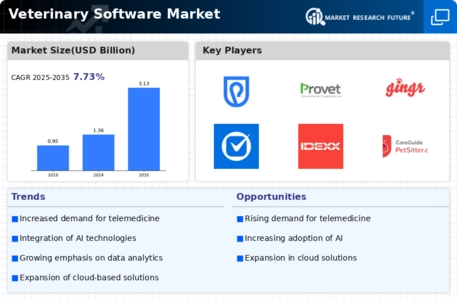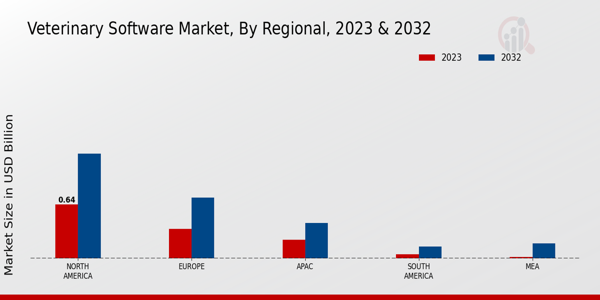-
EXECUTIVE SUMMARY
-
Market Overview
-
Key Findings
-
Market Segmentation
-
Competitive Landscape
-
Challenges and Opportunities
-
Future Outlook
-
MARKET INTRODUCTION
-
Definition
-
Scope of the study
- Research Objective
- Assumption
- Limitations
-
RESEARCH METHODOLOGY
-
Overview
-
Data Mining
-
Secondary Research
-
Primary Research
- Primary Interviews and Information Gathering Process
- Breakdown of Primary Respondents
-
Forecasting Model
-
Market Size Estimation
- Bottom-Up Approach
- Top-Down Approach
-
Data Triangulation
-
Validation
-
MARKET DYNAMICS
-
Overview
-
Drivers
-
Restraints
-
Opportunities
-
MARKET FACTOR ANALYSIS
-
Value chain Analysis
-
Porter's Five Forces Analysis
- Bargaining Power of Suppliers
- Bargaining Power of Buyers
- Threat of New Entrants
- Threat of Substitutes
- Intensity of Rivalry
-
COVID-19 Impact Analysis
- Market Impact Analysis
- Regional Impact
- Opportunity and Threat Analysis
-
VETERINARY SOFTWARE MARKET, BY SOFTWARE TYPE (USD BILLION)
-
Practice Management Software
-
Digital Imaging Software
-
Laboratory Management Software
-
Pharmacy Management Software
-
VETERINARY SOFTWARE MARKET, BY END USER (USD BILLION)
-
Veterinary Clinics
-
Animal Hospitals
-
Research Laboratories
-
Zoos
-
VETERINARY SOFTWARE MARKET, BY DEPLOYMENT TYPE (USD BILLION)
-
On-Premises
-
Cloud-Based
-
Hybrid
-
VETERINARY SOFTWARE MARKET, BY APPLICATION (USD BILLION)
-
Patient Management
-
Inventory Management
-
Billing Management
-
Telemedicine
-
VETERINARY SOFTWARE MARKET, BY REGIONAL (USD BILLION)
-
North America
- US
- Canada
-
Europe
- Germany
- UK
- France
- Russia
- Italy
- Spain
- Rest of Europe
-
APAC
- China
- India
- Japan
- South Korea
- Malaysia
- Thailand
- Indonesia
- Rest of APAC
-
South America
- Brazil
- Mexico
- Argentina
- Rest of South America
-
MEA
- GCC Countries
- South Africa
- Rest of MEA
-
COMPETITIVE LANDSCAPE
-
Overview
-
Competitive Analysis
-
Market share Analysis
-
Major Growth Strategy in the Veterinary Software Market
-
Competitive Benchmarking
-
Leading Players in Terms of Number of Developments in the Veterinary Software Market
-
Key developments and growth strategies
- New Product Launch/Service Deployment
- Merger & Acquisitions
- Joint Ventures
-
Major Players Financial Matrix
- Sales and Operating Income
- Major Players R&D Expenditure. 2023
-
COMPANY PROFILES
-
Veterinary Software Solutions
- Financial Overview
- Products Offered
- Key Developments
- SWOT Analysis
- Key Strategies
-
Hippo Manager
- Financial Overview
- Products Offered
- Key Developments
- SWOT Analysis
- Key Strategies
-
Vetspire
- Financial Overview
- Products Offered
- Key Developments
- SWOT Analysis
- Key Strategies
-
Provet
- Financial Overview
- Products Offered
- Key Developments
- SWOT Analysis
- Key Strategies
-
SaaS for Vets
- Financial Overview
- Products Offered
- Key Developments
- SWOT Analysis
- Key Strategies
-
Gingr
- Financial Overview
- Products Offered
- Key Developments
- SWOT Analysis
- Key Strategies
-
Clio
- Financial Overview
- Products Offered
- Key Developments
- SWOT Analysis
- Key Strategies
-
IDEXX Laboratories
- Financial Overview
- Products Offered
- Key Developments
- SWOT Analysis
- Key Strategies
-
Vetter Software
- Financial Overview
- Products Offered
- Key Developments
- SWOT Analysis
- Key Strategies
-
Petsit
- Financial Overview
- Products Offered
- Key Developments
- SWOT Analysis
- Key Strategies
-
Practice Solutions
- Financial Overview
- Products Offered
- Key Developments
- SWOT Analysis
- Key Strategies
-
Covetrus
- Financial Overview
- Products Offered
- Key Developments
- SWOT Analysis
- Key Strategies
-
eVetPractice
- Financial Overview
- Products Offered
- Key Developments
- SWOT Analysis
- Key Strategies
-
AVImark
- Financial Overview
- Products Offered
- Key Developments
- SWOT Analysis
- Key Strategies
-
VetTools
- Financial Overview
- Products Offered
- Key Developments
- SWOT Analysis
- Key Strategies
-
APPENDIX
-
References
-
Related Reports
-
LIST OF ASSUMPTIONS
-
NORTH AMERICA VETERINARY SOFTWARE MARKET SIZE ESTIMATES & FORECAST, BY SOFTWARE TYPE, 2019-2032 (USD BILLIONS)
-
NORTH AMERICA VETERINARY SOFTWARE MARKET SIZE ESTIMATES & FORECAST, BY END USER, 2019-2032 (USD BILLIONS)
-
NORTH AMERICA VETERINARY SOFTWARE MARKET SIZE ESTIMATES & FORECAST, BY DEPLOYMENT TYPE, 2019-2032 (USD BILLIONS)
-
NORTH AMERICA VETERINARY SOFTWARE MARKET SIZE ESTIMATES & FORECAST, BY APPLICATION, 2019-2032 (USD BILLIONS)
-
NORTH AMERICA VETERINARY SOFTWARE MARKET SIZE ESTIMATES & FORECAST, BY REGIONAL, 2019-2032 (USD BILLIONS)
-
US VETERINARY SOFTWARE MARKET SIZE ESTIMATES & FORECAST, BY SOFTWARE TYPE, 2019-2032 (USD BILLIONS)
-
US VETERINARY SOFTWARE MARKET SIZE ESTIMATES & FORECAST, BY END USER, 2019-2032 (USD BILLIONS)
-
US VETERINARY SOFTWARE MARKET SIZE ESTIMATES & FORECAST, BY DEPLOYMENT TYPE, 2019-2032 (USD BILLIONS)
-
US VETERINARY SOFTWARE MARKET SIZE ESTIMATES & FORECAST, BY APPLICATION, 2019-2032 (USD BILLIONS)
-
US VETERINARY SOFTWARE MARKET SIZE ESTIMATES & FORECAST, BY REGIONAL, 2019-2032 (USD BILLIONS)
-
CANADA VETERINARY SOFTWARE MARKET SIZE ESTIMATES & FORECAST, BY SOFTWARE TYPE, 2019-2032 (USD BILLIONS)
-
CANADA VETERINARY SOFTWARE MARKET SIZE ESTIMATES & FORECAST, BY END USER, 2019-2032 (USD BILLIONS)
-
CANADA VETERINARY SOFTWARE MARKET SIZE ESTIMATES & FORECAST, BY DEPLOYMENT TYPE, 2019-2032 (USD BILLIONS)
-
CANADA VETERINARY SOFTWARE MARKET SIZE ESTIMATES & FORECAST, BY APPLICATION, 2019-2032 (USD BILLIONS)
-
CANADA VETERINARY SOFTWARE MARKET SIZE ESTIMATES & FORECAST, BY REGIONAL, 2019-2032 (USD BILLIONS)
-
EUROPE VETERINARY SOFTWARE MARKET SIZE ESTIMATES & FORECAST, BY SOFTWARE TYPE, 2019-2032 (USD BILLIONS)
-
EUROPE VETERINARY SOFTWARE MARKET SIZE ESTIMATES & FORECAST, BY END USER, 2019-2032 (USD BILLIONS)
-
EUROPE VETERINARY SOFTWARE MARKET SIZE ESTIMATES & FORECAST, BY DEPLOYMENT TYPE, 2019-2032 (USD BILLIONS)
-
EUROPE VETERINARY SOFTWARE MARKET SIZE ESTIMATES & FORECAST, BY APPLICATION, 2019-2032 (USD BILLIONS)
-
EUROPE VETERINARY SOFTWARE MARKET SIZE ESTIMATES & FORECAST, BY REGIONAL, 2019-2032 (USD BILLIONS)
-
GERMANY VETERINARY SOFTWARE MARKET SIZE ESTIMATES & FORECAST, BY SOFTWARE TYPE, 2019-2032 (USD BILLIONS)
-
GERMANY VETERINARY SOFTWARE MARKET SIZE ESTIMATES & FORECAST, BY END USER, 2019-2032 (USD BILLIONS)
-
GERMANY VETERINARY SOFTWARE MARKET SIZE ESTIMATES & FORECAST, BY DEPLOYMENT TYPE, 2019-2032 (USD BILLIONS)
-
GERMANY VETERINARY SOFTWARE MARKET SIZE ESTIMATES & FORECAST, BY APPLICATION, 2019-2032 (USD BILLIONS)
-
GERMANY VETERINARY SOFTWARE MARKET SIZE ESTIMATES & FORECAST, BY REGIONAL, 2019-2032 (USD BILLIONS)
-
UK VETERINARY SOFTWARE MARKET SIZE ESTIMATES & FORECAST, BY SOFTWARE TYPE, 2019-2032 (USD BILLIONS)
-
UK VETERINARY SOFTWARE MARKET SIZE ESTIMATES & FORECAST, BY END USER, 2019-2032 (USD BILLIONS)
-
UK VETERINARY SOFTWARE MARKET SIZE ESTIMATES & FORECAST, BY DEPLOYMENT TYPE, 2019-2032 (USD BILLIONS)
-
UK VETERINARY SOFTWARE MARKET SIZE ESTIMATES & FORECAST, BY APPLICATION, 2019-2032 (USD BILLIONS)
-
UK VETERINARY SOFTWARE MARKET SIZE ESTIMATES & FORECAST, BY REGIONAL, 2019-2032 (USD BILLIONS)
-
FRANCE VETERINARY SOFTWARE MARKET SIZE ESTIMATES & FORECAST, BY SOFTWARE TYPE, 2019-2032 (USD BILLIONS)
-
FRANCE VETERINARY SOFTWARE MARKET SIZE ESTIMATES & FORECAST, BY END USER, 2019-2032 (USD BILLIONS)
-
FRANCE VETERINARY SOFTWARE MARKET SIZE ESTIMATES & FORECAST, BY DEPLOYMENT TYPE, 2019-2032 (USD BILLIONS)
-
FRANCE VETERINARY SOFTWARE MARKET SIZE ESTIMATES & FORECAST, BY APPLICATION, 2019-2032 (USD BILLIONS)
-
FRANCE VETERINARY SOFTWARE MARKET SIZE ESTIMATES & FORECAST, BY REGIONAL, 2019-2032 (USD BILLIONS)
-
RUSSIA VETERINARY SOFTWARE MARKET SIZE ESTIMATES & FORECAST, BY SOFTWARE TYPE, 2019-2032 (USD BILLIONS)
-
RUSSIA VETERINARY SOFTWARE MARKET SIZE ESTIMATES & FORECAST, BY END USER, 2019-2032 (USD BILLIONS)
-
RUSSIA VETERINARY SOFTWARE MARKET SIZE ESTIMATES & FORECAST, BY DEPLOYMENT TYPE, 2019-2032 (USD BILLIONS)
-
RUSSIA VETERINARY SOFTWARE MARKET SIZE ESTIMATES & FORECAST, BY APPLICATION, 2019-2032 (USD BILLIONS)
-
RUSSIA VETERINARY SOFTWARE MARKET SIZE ESTIMATES & FORECAST, BY REGIONAL, 2019-2032 (USD BILLIONS)
-
ITALY VETERINARY SOFTWARE MARKET SIZE ESTIMATES & FORECAST, BY SOFTWARE TYPE, 2019-2032 (USD BILLIONS)
-
ITALY VETERINARY SOFTWARE MARKET SIZE ESTIMATES & FORECAST, BY END USER, 2019-2032 (USD BILLIONS)
-
ITALY VETERINARY SOFTWARE MARKET SIZE ESTIMATES & FORECAST, BY DEPLOYMENT TYPE, 2019-2032 (USD BILLIONS)
-
ITALY VETERINARY SOFTWARE MARKET SIZE ESTIMATES & FORECAST, BY APPLICATION, 2019-2032 (USD BILLIONS)
-
ITALY VETERINARY SOFTWARE MARKET SIZE ESTIMATES & FORECAST, BY REGIONAL, 2019-2032 (USD BILLIONS)
-
SPAIN VETERINARY SOFTWARE MARKET SIZE ESTIMATES & FORECAST, BY SOFTWARE TYPE, 2019-2032 (USD BILLIONS)
-
SPAIN VETERINARY SOFTWARE MARKET SIZE ESTIMATES & FORECAST, BY END USER, 2019-2032 (USD BILLIONS)
-
SPAIN VETERINARY SOFTWARE MARKET SIZE ESTIMATES & FORECAST, BY DEPLOYMENT TYPE, 2019-2032 (USD BILLIONS)













Leave a Comment